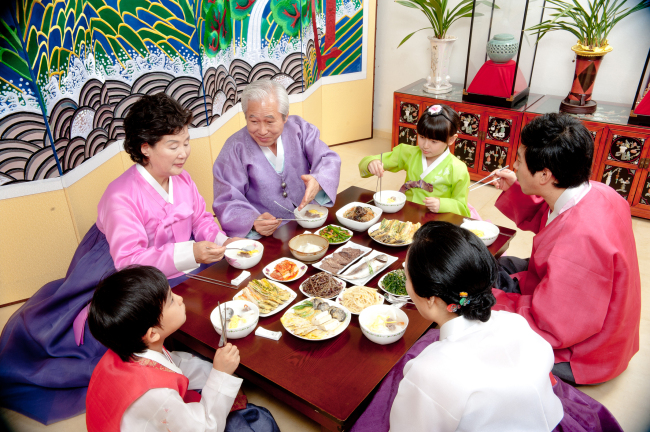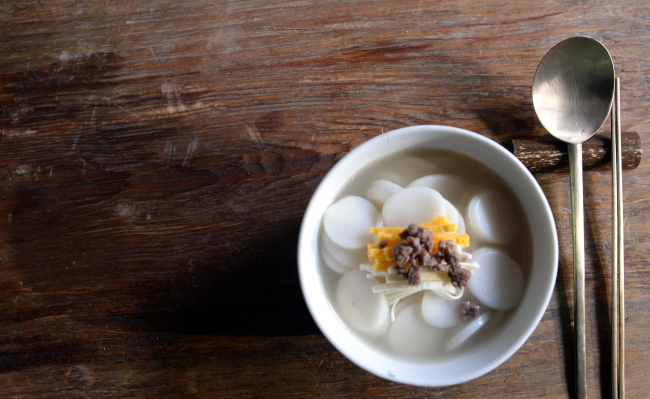[Weekender] Rice-cake soup remains Seollal staple
Exploring the eating traditions of the Korean Lunar New Year table
By Korea HeraldPublished : Jan. 24, 2014 - 20:39

Tteokguk, that steaming bowl of hot broth studded with slices of white rice cake, is a classic Seollal staple.
“In Korea, placing a bowl of tteokguk on the ancestral table for rites on Lunar New Year’s morning is tradition,” said Dadam executive chef Jeong Jae-deok.
Even at Dadam, a Korean fine dining restaurant located in Seoul’s Cheongdam-dong, Jeong makes a point of serving rice cake soup on both New Year’s Day and Seollal in lieu of the customary porridge that accompanies meals.
The symbolic significance of tteokguk, Jeong went on to explain, stems in part from garaetteok, a long strand of rice cake that is sliced into ovals or circles to make the classic dish.
According to Jeong, white garaetteok signifies “purity and longevity.”
“So it symbolizes a long and healthy life,” Jeong, 36, elaborated, also divulging an old saying: “‘One needs to eat a bowl of tteokguk on Seollal morning in order to grow a year older.’”
Prosperity and good luck, Haap owner-chef Sin Yong-il said, are also symbols associated with tteokguk.
According to Sin, who crafts artisanal rice cakes from his boutique in Cheongdam-dong, garaetteok was initially cut into coin-shaped circles and signified money and good fortune.
Sin, who is making tteokguk rice cakes at Haap for the first time this year, opted to craft dainty coin-shaped slices himself, which he feels are aesthetically pleasing and give a “clean and modest” feel to the dish.
For Sin, there are certain guidelines to crafting rice cakes for tteokguk.
The veteran rice cake chef demonstrated by picking up a small, round, slightly translucent tteok, nibbling at it to check if it had been seasoned with the right amount of salt.
Then he showed how after the rice cake had been added to the soup, it still retained its shape and chewiness instead of becoming too mushy or gooey.
“If it bloats and loses its original shape then something is wrong,” Sin, 40, said.
How the garaetteok is made also matters, said Sin, explaining that it should be passed through the rice cake press three times.
Why?
According to Sin, by repeatedly extracting garaetteok one can get rice cake that is dense in texture, so that when sliced there are no holes or gaps on the surface, just smooth, finely grained tteok.
Once extracted, Sin explained, the garaetteok is soft and chewy, making it difficult to slice.
The strands of rice cake should be air-dried, a process that involves rotating the garaetteok occasionally so it dries evenly. Once dried, the tteok needs to be sliced.
Sin believes that thin slices are ideal for easy-to-chew tteok that feels pleasant in the mouth.
Then it is time to eat this Proustian treat that conjures up childhood memories with each tasty spoonful.
Sin still remembers how households used to stock up on freshly harvested rice in the autumn to last through to the next year. When winter rolled around, there would be plenty of rice left.
Families would draw from those reserves of white grain, going to the local mill to have it ground and made into those long strands of rice cake called garaetteok.
The soft and fresh tteok would be taken home, dried and cut.
While tteok plays a crucial role in the dish, Dadam’s Jeong also believes that the broth itself and the ratio of soup to tteok is important as well.
In Jeong’s opinion, the ideal ratio is 40 percent tteok to 60 percent broth, so that one does not get too much rice cake or too much soup.
Then there is the broth itself.
For a deep and flavorful soup, beef leg bone stock is slow-cooked for a long time at Dadam, Jeong revealed.
“When you are making the stock, boil it once and then simmer for a long time at medium heat, because if you keep boiling it at high heat you will compromise the flavor of the soup,” Jeong advised.
While tteokguk is traditionally considered the centerpiece of the Seollal table, it is hardly the sole treat that families gather to feast on during this special day.
Galbijjim, a dish of braised beef short ribs, is yet another Lunar New Year favorite.
According to Jeong, galbijjim is considered an upscale treat that can be enjoyed on special days like Seollal.
For those who have developed a taste for those sweet, rich ribs, gnawing at every last bit of flesh and scooping up those beefy juices and drizzling them over glistening white rice to prolong the delight of this dish, galbijjim is definitely something to look forward to on Lunar New Year.
Yet making it can be somewhat tricky. Leave it too long on the stove and it might burn. Simmer it too quickly and it could emerge watery and slightly bland.
Jeong passed on some tips for making the holiday dish.
At Dadam, galbijjim gets the royal treatment by being sprinkled liberally with chopped pine nuts. The effect is utterly decadent, adding a layer of nutty richness and slightly crunchy texture to the dish.
To create the garnish at home, Jeong revealed, the key is paper towels.
Pine nuts, he explained, can be quite oily, so before mincing the nuts with a knife, lay a paper towel down on the cutting board or else the whole thing might turn into a mushy paste, he warned.
For depth of flavor, Jeong recommends mixing a little bit of Joseon ganjang, also called soup soy sauce or Korean soy sauce, with soy sauce.
“Joseon ganjang has been aged for a long time so it possesses deep flavors,” Jeong explained.
To prevent the dish from getting too rich and greasy, Jeong suggests adding dried pyogo mushrooms when adding all the other seasonings to the galbijjim and slow-cooking it.
Haap’s tteokguk

Serves 4
Ingredients:
• 3 sliced garaetteok
• 8 cups beef broth
• 60 g minced beef
• 1 egg
• 1 tbsp soup soy sauce
• 1 tsp soy sauce
• 1 tsp sugar
• 1 tsp sesame seed oil
• 1/2 tsp minced garlic
• cooking oil, enough to coat the frypan
• salt and pepper to taste
Directions
1. Season minced beef with soy sauce, sugar, sesame seed oil and minced garlic and stir-fry slightly in a frying pan till cooked. Set aside.
2. Separate the egg whites and yolk. Season both whites and yolk with salt to taste. Mix both separately. Coat frying pan with a little cooking oil and make a thin egg white omelet and a thin egg yolk omelet. Slice omelets into thin strips. Set aside.
3. Season beef broth with soup soy sauce and salt to taste, and boil. Rinse the sliced garaetteok and add to broth. When the tteok is cooked, put in bowls and top with strips of omelet, minced seasoned beef and a little black pepper. Serve.
By Jean Oh (oh_jean@heraldcorp.com)
Ingredients:
• 3 sliced garaetteok
• 8 cups beef broth
• 60 g minced beef
• 1 egg
• 1 tbsp soup soy sauce
• 1 tsp soy sauce
• 1 tsp sugar
• 1 tsp sesame seed oil
• 1/2 tsp minced garlic
• cooking oil, enough to coat the frypan
• salt and pepper to taste
Directions
1. Season minced beef with soy sauce, sugar, sesame seed oil and minced garlic and stir-fry slightly in a frying pan till cooked. Set aside.
2. Separate the egg whites and yolk. Season both whites and yolk with salt to taste. Mix both separately. Coat frying pan with a little cooking oil and make a thin egg white omelet and a thin egg yolk omelet. Slice omelets into thin strips. Set aside.
3. Season beef broth with soup soy sauce and salt to taste, and boil. Rinse the sliced garaetteok and add to broth. When the tteok is cooked, put in bowls and top with strips of omelet, minced seasoned beef and a little black pepper. Serve.
By Jean Oh (oh_jean@heraldcorp.com)
-
Articles by Korea Herald



















![[Today’s K-pop] BTS pop-up event to come to Seoul](http://res.heraldm.com/phpwas/restmb_idxmake.php?idx=642&simg=/content/image/2024/04/17/20240417050734_0.jpg&u=)